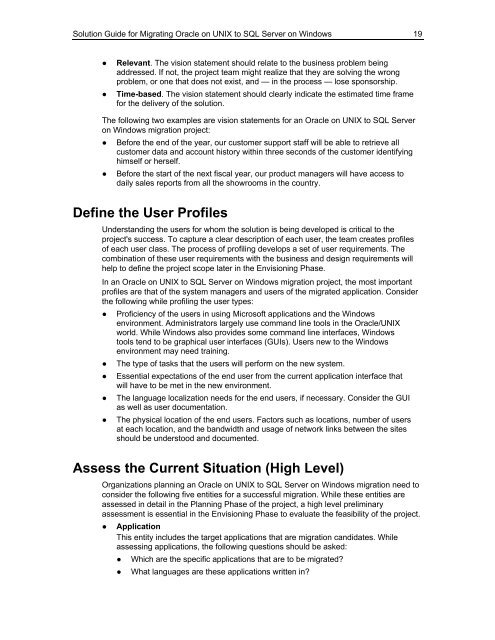Solution Guide for Migrating Oracle on UNIX to SQL Server - Willy .Net
Solution Guide for Migrating Oracle on UNIX to SQL Server - Willy .Net
Solution Guide for Migrating Oracle on UNIX to SQL Server - Willy .Net
- No tags were found...
You also want an ePaper? Increase the reach of your titles
YUMPU automatically turns print PDFs into web optimized ePapers that Google loves.
<str<strong>on</strong>g>Soluti<strong>on</strong></str<strong>on</strong>g> <str<strong>on</strong>g>Guide</str<strong>on</strong>g> <str<strong>on</strong>g>for</str<strong>on</strong>g> <str<strong>on</strong>g>Migrating</str<strong>on</strong>g> <str<strong>on</strong>g>Oracle</str<strong>on</strong>g> <strong>on</strong> <strong>UNIX</strong> <strong>to</strong> <strong>SQL</strong> <strong>Server</strong> <strong>on</strong> Windows 19●●Relevant. The visi<strong>on</strong> statement should relate <strong>to</strong> the business problem beingaddressed. If not, the project team might realize that they are solving the wr<strong>on</strong>gproblem, or <strong>on</strong>e that does not exist, and — in the process — lose sp<strong>on</strong>sorship.Time-based. The visi<strong>on</strong> statement should clearly indicate the estimated time frame<str<strong>on</strong>g>for</str<strong>on</strong>g> the delivery of the soluti<strong>on</strong>.The following two examples are visi<strong>on</strong> statements <str<strong>on</strong>g>for</str<strong>on</strong>g> an <str<strong>on</strong>g>Oracle</str<strong>on</strong>g> <strong>on</strong> <strong>UNIX</strong> <strong>to</strong> <strong>SQL</strong> <strong>Server</strong><strong>on</strong> Windows migrati<strong>on</strong> project:● Be<str<strong>on</strong>g>for</str<strong>on</strong>g>e the end of the year, our cus<strong>to</strong>mer support staff will be able <strong>to</strong> retrieve allcus<strong>to</strong>mer data and account his<strong>to</strong>ry within three sec<strong>on</strong>ds of the cus<strong>to</strong>mer identifyinghimself or herself.● Be<str<strong>on</strong>g>for</str<strong>on</strong>g>e the start of the next fiscal year, our product managers will have access <strong>to</strong>daily sales reports from all the showrooms in the country.Define the User ProfilesUnderstanding the users <str<strong>on</strong>g>for</str<strong>on</strong>g> whom the soluti<strong>on</strong> is being developed is critical <strong>to</strong> theproject's success. To capture a clear descripti<strong>on</strong> of each user, the team creates profilesof each user class. The process of profiling develops a set of user requirements. Thecombinati<strong>on</strong> of these user requirements with the business and design requirements willhelp <strong>to</strong> define the project scope later in the Envisi<strong>on</strong>ing Phase.In an <str<strong>on</strong>g>Oracle</str<strong>on</strong>g> <strong>on</strong> <strong>UNIX</strong> <strong>to</strong> <strong>SQL</strong> <strong>Server</strong> <strong>on</strong> Windows migrati<strong>on</strong> project, the most importantprofiles are that of the system managers and users of the migrated applicati<strong>on</strong>. C<strong>on</strong>siderthe following while profiling the user types:● Proficiency of the users in using Microsoft applicati<strong>on</strong>s and the Windowsenvir<strong>on</strong>ment. Administra<strong>to</strong>rs largely use command line <strong>to</strong>ols in the <str<strong>on</strong>g>Oracle</str<strong>on</strong>g>/<strong>UNIX</strong>world. While Windows also provides some command line interfaces, Windows<strong>to</strong>ols tend <strong>to</strong> be graphical user interfaces (GUIs). Users new <strong>to</strong> the Windowsenvir<strong>on</strong>ment may need training.● The type of tasks that the users will per<str<strong>on</strong>g>for</str<strong>on</strong>g>m <strong>on</strong> the new system.● Essential expectati<strong>on</strong>s of the end user from the current applicati<strong>on</strong> interface thatwill have <strong>to</strong> be met in the new envir<strong>on</strong>ment.● The language localizati<strong>on</strong> needs <str<strong>on</strong>g>for</str<strong>on</strong>g> the end users, if necessary. C<strong>on</strong>sider the GUIas well as user documentati<strong>on</strong>.● The physical locati<strong>on</strong> of the end users. Fac<strong>to</strong>rs such as locati<strong>on</strong>s, number of usersat each locati<strong>on</strong>, and the bandwidth and usage of network links between the sitesshould be unders<strong>to</strong>od and documented.Assess the Current Situati<strong>on</strong> (High Level)Organizati<strong>on</strong>s planning an <str<strong>on</strong>g>Oracle</str<strong>on</strong>g> <strong>on</strong> <strong>UNIX</strong> <strong>to</strong> <strong>SQL</strong> <strong>Server</strong> <strong>on</strong> Windows migrati<strong>on</strong> need <strong>to</strong>c<strong>on</strong>sider the following five entities <str<strong>on</strong>g>for</str<strong>on</strong>g> a successful migrati<strong>on</strong>. While these entities areassessed in detail in the Planning Phase of the project, a high level preliminaryassessment is essential in the Envisi<strong>on</strong>ing Phase <strong>to</strong> evaluate the feasibility of the project.● Applicati<strong>on</strong>This entity includes the target applicati<strong>on</strong>s that are migrati<strong>on</strong> candidates. Whileassessing applicati<strong>on</strong>s, the following questi<strong>on</strong>s should be asked:● Which are the specific applicati<strong>on</strong>s that are <strong>to</strong> be migrated?● What languages are these applicati<strong>on</strong>s written in?
















